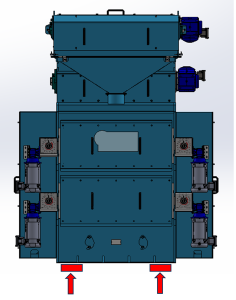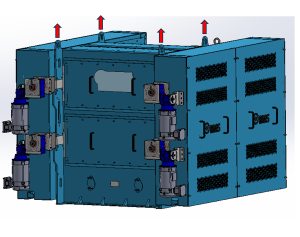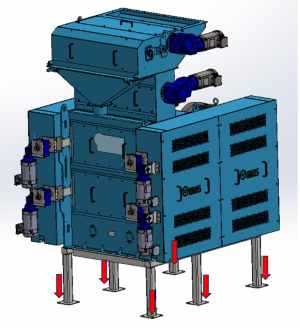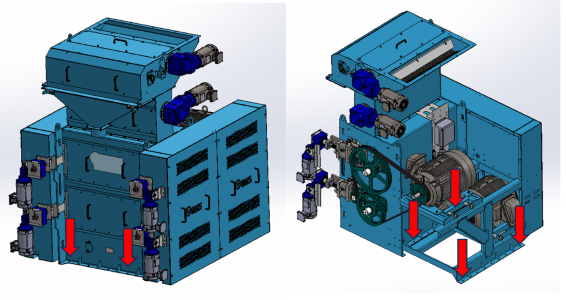Feed Mill Installation
Find the Pre-Start-Up Checklist HERE !
Lifting the machine
When installing a machine, it must be lifted in the proper way to ensure safety and eliminate the potential of damaging the machine.
The machine can be lifted from the bottom using a forklift. The forks should be spread out as close to the side plate of the mill frame as possible to ensure stability.
See image below:

The machine can also be lifted from the top using the lifting eyes that are built into the mill frame. Proper rigging must be used to ensure the load is lifted vertically at each attachment point. The use of a lifting/spreader beam is recommended to reduce the likelihood of damaging the machine.
See image below:

Note: Forklift must have a rated capacity that is higher than the overall weight of the equipment being lifted.
Installing a machine on a stand
If the machine is installed on a stand it is critical that this stand is built to handle the overall weight of the machine and product that will be in the machine. As a general rule of thumb the stand should be built will a 1.5 to 1 safety factor.
It is recommended to anchor the mill stand using Grade 5, 1/2" concrete anchors at a minimum thread length of 1-1/2". Anchor depth may vary based on application. Anchors should be torqued to approximately 40 ft. lbs.
An example of mill stand anchor locations is shown below:

Bolting machine to the ground:
Concrete anchor bolts must be used when the machine is being installed on concrete. If the machine is being installed on a steel platform grade 5 bolts or better should be used. Machines should be checked for level, no matter where they are installed, before being secured.
It is recommended to anchor the mill stand using Grade 5, 1/2" concrete anchors at a minimum thread length of 1-1/2". Anchor depth may vary based on application. Anchors should be torqued to approximately 40 ft. lbs.
An example of mill anchor locations is shown below:

To prevent dust leaks:
After the machine is in place and bolted, the seams between each flange should be sealed with silicone caulk, to ensure it stays dust tight.
Clearances around the machine:
It is important to take into consideration the room you will require for roll changes and routine maintenance work when deciding where to place your machine. Call RMS for recommended clearances.